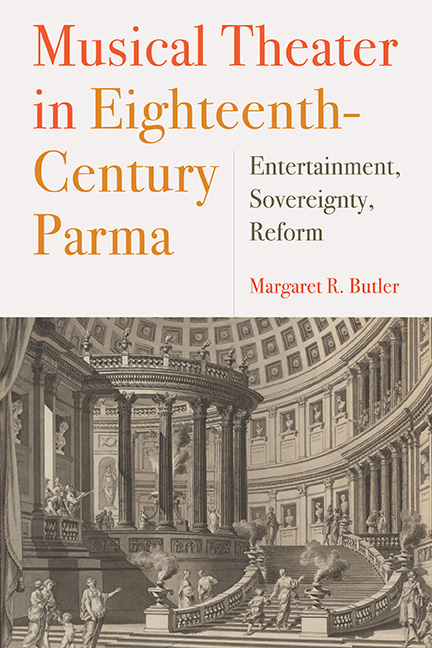Book contents
- Frontmatter
- Dedication
- Contents
- List of Illustrations
- Acknowledgments
- List of Abbreviations
- Notes to the Reader
- Introduction: The Genre Problem: Reform as Continuum and Brand
- 1 The Genesis of Parma's Projet
- 2 Behind the Scenes: Production and Management at the Teatro Ducale
- 3 The French Entertainments: Creation, Publicity, Propaganda
- 4 Moving On While Looking Back: Traetta's First Parma Operas
- 5 The End of the End of Reform: The Wedding, the French Ambassador's Opera, Traetta's Departure
- Conclusion: Reform Revisited
- Appendix: General Chronology
- Notes
- Bibliography
- Index
Conclusion: Reform Revisited
Published online by Cambridge University Press: 24 October 2019
- Frontmatter
- Dedication
- Contents
- List of Illustrations
- Acknowledgments
- List of Abbreviations
- Notes to the Reader
- Introduction: The Genre Problem: Reform as Continuum and Brand
- 1 The Genesis of Parma's Projet
- 2 Behind the Scenes: Production and Management at the Teatro Ducale
- 3 The French Entertainments: Creation, Publicity, Propaganda
- 4 Moving On While Looking Back: Traetta's First Parma Operas
- 5 The End of the End of Reform: The Wedding, the French Ambassador's Opera, Traetta's Departure
- Conclusion: Reform Revisited
- Appendix: General Chronology
- Notes
- Bibliography
- Index
Summary
Parma has long been recognized as a city where Italian and French operatic traditions encountered each other, a fruitful comingling that nourished Traetta's reform operas for the city's Teatro Ducale. As the foregoing discussion demonstrates, the works represented many things. They symbolized the merging of two powerful dynasties, the Habsburgs and Bourbons, representing a cultural transfer with wide-reaching political and social implications, as well as musical and theatrical ones. They also represented adaptation: Traetta's operas are the culmination, and not the inception, of a process of adaptation that can only be fully understood by appreciating how that process worked in the French entertainments that preceded them in Parma. Taken together, the French works and Traetta's Italian, French-inspired operas, show how malleable, variable, and creative the adaptation process could be. Parma's mid-eighteenth-century theater demonstrated this reality more clearly and prominently than any other contemporary opera theater in all of Europe was able to do, even others where French influence was strong and where there was interest in and support for presenting French and Frenchinspired cultural products. The adaptation process began not with Traetta's famous Ippolito ed Aricia, but much earlier, with the very first French work the troupe gave for the public, soon after the performers arrived in Parma: Zelindor, re’ dei silfi, with its additional aria that showcased Parma's new, leading haute-contre. With Gl'Incà del Perù, the adaptation grew into something much more significant, as the short entrée from Rameau's Les Indes galantes became extended, encompassing new pieces and ensembles, and concluding with an added divertissement that showcased different performers, dancers as Spanish soldiers, in an addition and expansion of the work that unmistakably represented Spanish Bourbon power. Castore e Polluce represents a more subtle but no less important type of adaptation, as Castor's final aria became longer, more expressive, and weightier, developing into a full-blown choral number that again showcased the strength of Parma's new performing forces. Anacreonte revealed to Parma audiences how one genre could be transformed into another, an acte from an opéra-ballet becoming a balletto, presenting more opportunities to highlight the French troupe's expert dancers.
What else do Traetta's operas signify? They certainly represent innovation, with their synthesis of Italian and French components.
- Type
- Chapter
- Information
- Musical Theater in Eighteenth-Century ParmaEntertainment, Sovereignty, Reform, pp. 127 - 130Publisher: Boydell & BrewerPrint publication year: 2019



